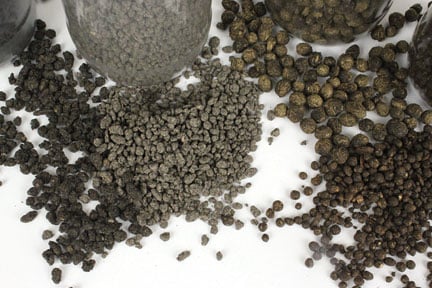You’ve probably seen the dairy ads on television, where talking cows rhapsodize on the joy of being part of the family, or lean over the top of a wooden fence for a chat, with gorgeous green grass beneath their feet. The scenes are bucolic and clean, with nary a cowpat in sight. Unfortunately, the reality is not always so pastoral. Herd sizes have increased, while farm and ranch land has been gobbled up by industrial parks and subdivisions, meaning that the amount of land available for each head of livestock—be they cattle, goats, pigs, horses, chickens, turkeys, or llamas—has decreased dramatically in recent years. For example, in Texas alone, over 2.1 million acres of forest, ranch and farm lands were taken over for other uses between 1997 and 2007. Most of this was due to population increase, as approximately 149 acres of agricultural lands were converted for every thousand new residents in the state. Those new residents also need to eat, and this puts increasing pressure on the agricultural and livestock industries to provide additional food from ever-smaller plots of land. This also means that there is no longer space available to allow increasingly larger piles of manure to age or compost. All that land is needed for higher priorities.
Why Over-Applying Manure is not the Answer
The average dairy cow generates 64 pounds of manure per day, or over 11 tons per year, while the average hog generates 14 pounds per day, or 2.5 tons per year. This means that dairy farmers and livestock producers have a huge, and ever-growing, problem on their hands. Unfortunately, it’s not just a matter of finding scarce field space to store the manure, because such large piles leach excess nutrients into the soil and local groundwater. The concentration of nutrients in specific locations—such as these piles of manure at the edge of livestock farms—is also detrimental to soil ecology as a whole. Studies are now showing that modern farming techniques are removing more nutrients from the soil than they are replenishing, even with the help of modern inorganic fertilizers. This means that each generation of crops contains fewer nutrients than the last, slowly stripping the soil of crucial macro- and micronutrients. Not only that, but soil only takes in the amount of nutrients that it needs, while the rest is wasted in the form of run-off. This means that piles of manure can leach a high concentration of both nutrients and pathogens into the surrounding groundwater, especially if there is a drainage ditch, pond, stream, or wetland nearby. Increased nutrient levels in such waters lead to excessive algae growth, which reduces wildlife habitat and clogs recreational water sources. Odor from manure piles can also be a major problem for neighbors.
The Cost of Manure
What is a livestock manager to do? When manure must be stored on the property, it can be contained by piling it on an area lined with a concrete pad or plastic, and covering it with more of the same. It can be stored in dumpsters, dump trucks, or trailers, which are hauled away when full. Usually there are regulations which must be followed, with fees and fines assessed when the piles of manure get out of control. This means that handling manure is expensive. If a structure is built to house it, the cost to build and maintain it (including everything from the ramp, to insurance, to the interest rate on the loan) must be taken into account. Equipment must be purchased to move all that manure (with associated costs for insurance and interest on the loan to purchase the equipment) and labor paid to run the equipment. Shipping it offsite is extremely expensive, and brings another set of costs, paid to the hauling company, its employees, and the company at the other end that will be disposing of the manure. Researchers have determined that the average cost of manure alone for hog farmers in the US averages out to a penny per pound of hog, and can be as high as 1.8 cents in some areas of the country. While that may not seem like much, consider that the size of a hog farm can be as high as 1,200 head, at an average of 220 pounds each. That means a cost in a range of $2,640-$4,752 for a single such farm.
The Wealth Within Manure
While manure may have gained a bad rap for the problems it poses, people are beginning to discover that it also offers a solution. Granulating manure into a dry, organic-based fertilizer product not only alleviates many of the problems associated with manure, but also harnesses the valuable nutrient content contained within manure. All those nutrients that cause excess algae growth when they leach into nearby water supplies could be put to much better use in fertilizing the next generation of crops to feed all that hungry livestock. Moreover, organic fertilizer made from manure contains abundant micronutrients not naturally found in the inorganic fertilizer compounds that focus only on NPK, or Nitrogen, Phosphorous, and Potassium. Furthermore, inorganic sources of phosphorous and potassium, potash and phosphate rock, are becoming increasingly scarce. Recycling organic waste into fertilizer eliminates the problem of being dependent on finite resources. In fact, the granulation of organic waste into fertilizer addresses several problems at once:
- Piles of manure will no longer overtake fields that are needed to grow food for people and livestock.
- The nutrients hidden within those piles of manure will no longer go to waste, polluting local water sources and damaging ecosystems.
- Soils will be replenished at measureable and appropriate rates.
- Organic waste is an infinitely renewable fertilizer resource.
In addition to the benefits that are reaped by the soil and surrounding ecosystems, converting manure into uniform granules or pellets also offers a multitude of benefits for the end user:
- Dry granules are significantly easier and more cost effective to transport than their raw, wet counterpart.
- The high heat of the dryers used in the granulating process removes any harmful pathogens or micro-organisms, leaving only safe, nutritious food for crops and fields.
- The granulation process also reduces odor, producing dry granules that are virtually odor-free.
- Dry granules offer a nutrient rich, premium fertilizer product that can be sold for profit.
- As opposed to manure, which must be used immediately, granules can be stored and used as needed.
- Dry granules are much easier to spread, and are compatible with modern machinery used in precision agriculture applications.
Granulated organics are an excellent way to both eliminate waste and recycle those essential nutrients back into the fields where they belong. The sustainability of life on earth is dependent upon our ability to produce food in sufficient quantities to feed both ourselves, and the animals around us. The granulation of waste into fertilizer will transform our future by recycling critical nutrients into the soil that desperately needs them in order to keep feeding all those hungry mouths. The process will also help to create a closed loop system, where waste does not pile up, but rather, becomes the raw material for a fresh start. FEECO has been leading the way in organics granulation technology for decades, helping companies to transform problematic amounts of manure into a valuable end product. From feasibility testing, to product and process development, and custom equipment, FEECO offers a family of solutions to meet the needs of the manure management industry. For more information on organics granulation, contact us today!



